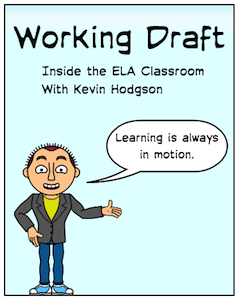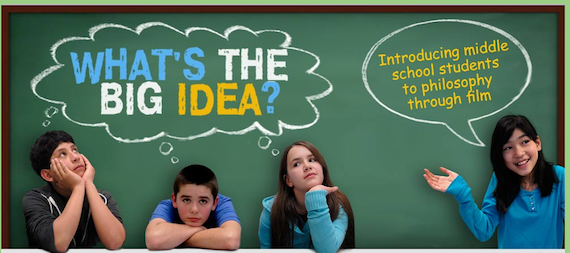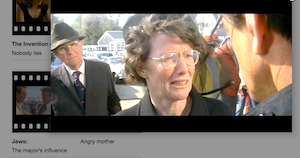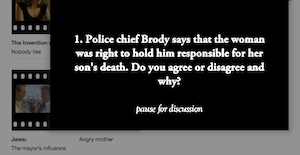Using Philosophy & the Movies to Teach Close Reading in 6th Grade
A MiddleWeb Blog
 Can we use video as text? I recently came across a fascinating piece by the late film critic Roger Ebert where he systematically broke down the ways we can “read a movie.”
Can we use video as text? I recently came across a fascinating piece by the late film critic Roger Ebert where he systematically broke down the ways we can “read a movie.”
In the article, Ebert explains the use of camera angles, left to right movements, lighting and other elements of film composition that we often don’t see or notice when we are munching on our popcorn in the theater. We’re just watching the movie.
Ebert shows us how much more is going on, if we just pay attention. His piece is like opening the curtain on the stage, revealing the inner workings of the camera’s unseen eye.
Now think about how much video is consumed by young people every day. If you want to be flabbergasted by the flow of media uploaded, shared and watched on a global scale, check out Gary Haye’s Social Media Counter. Turn the site on and stare at the data.
The numbers are jawdropping. Our students are part of those numbers, too, with their cell phones, sharing apps, social networking sites, and more. They are a visual generation, watching videos but also creating them, too.
What’s the Big Idea?
Which brings me to my sixth grade classroom, where I have been working to bring elements of close reading skills to the screen, too. There’s been no better way for me to merge a few important ideas, including some basics elements of philosophy, than to use a site called What’s the Big Idea?
Tom Wartenberg Intro from Julie Akeret on Vimeo.
Innovative in its approach to using media for learning, the grant-funded site uses short clips from Hollywood movies and television to set the stage for discussions around ethics and philosophy, with middle school students as its main target audience.
There are topics around bullying, friendship, and peer pressure. Tom Wartenberg, a professor at Mount Holyoke College, introduces the topics and the philosophical element in a kid-friendly way, and there are videos for teachers and for students (as well as handy downloadable documents to guide discussions).
I use What’s the Big Idea? for thematic topics of lying and environmental ethics, tying those discussions right into our work in literature. For some reason, a lot of characters in many of the books we read are not apt to tell the truth (Regarding the Fountain, The Mostly True Adventures of Homer P. Figg, etc.) and the protection and misuse of the environment is a theme in a lot of our non-fiction reading and novels like Flush. Middle school students are passionate about the planet.
The philosophy site’s film and television clips – from movies like Jaws, Avatar, The Lorax, Freaks and Geeks, and Liar Liar – engage the students in ways that our reading text doesn’t. No surprise there. But each clip at the site is followed by a probing question to spark a discussion around specific ethical and moral decisions.
Deep and nuanced discussions
The range of discussions with my students that come from these video-inspired activities is deep and rich and very nuanced. The talks often lead into some interesting writing about character motivations and author’s intent. As I teach synthesis across multiple “texts,” these videos become another resource in my toolbox.
And with Ebert in mind we even pay attention to the video itself — how is the scene unfolding, what focus does the camera have, where does the view come into focus and out of focus, and more. It’s not just ethics; it’s reading a screen, and understanding the impact that a piece of media can have on us as viewers.
Developmentally, my sixth graders are across the spectrum when it comes to these kinds of discussions about ethics. Many still want to see the world in the strict dichotomy of right and wrong, and they often struggle to see the gray area in-between that marks so much our lives. Questions around “When is it OK to tell a lie?” and “What obligation do people have to other animals around us?” are ones we grapple with. So do most adults.
And yet, my students encounter these ethical choices daily all around them, either in their own lives, in the books they read, or in the videos they watch. The clips from the site help them think through difficult issues in a safe space, with a medium of media they know very well.





































I created a “language of film” website as a resource for educators who want to help their students dive deeper into camera, lights, sound, and more. Take a look at http://www.frankwbaker.com/language_of_film
Very interesting, in deed! Do you have any information on using videos in lower elementary grades such as K-4? I would love to know. Thanks!
I’d advise every educator who uses video to consider introducing some pre-viewing questions as well as any concepts or vocabulary they want to call attention to. Visual literacy should not be overlooked here: how does the selection of images impact student understanding of what’s on the screen. Critical viewing skills can be introduced at the early grades. Frank Baker, Media Literacy Clearinghouse, http://www.frankwbaker.com
Thanks, Frank. Your work is something I turn to a lot around visual literacy and video as text.